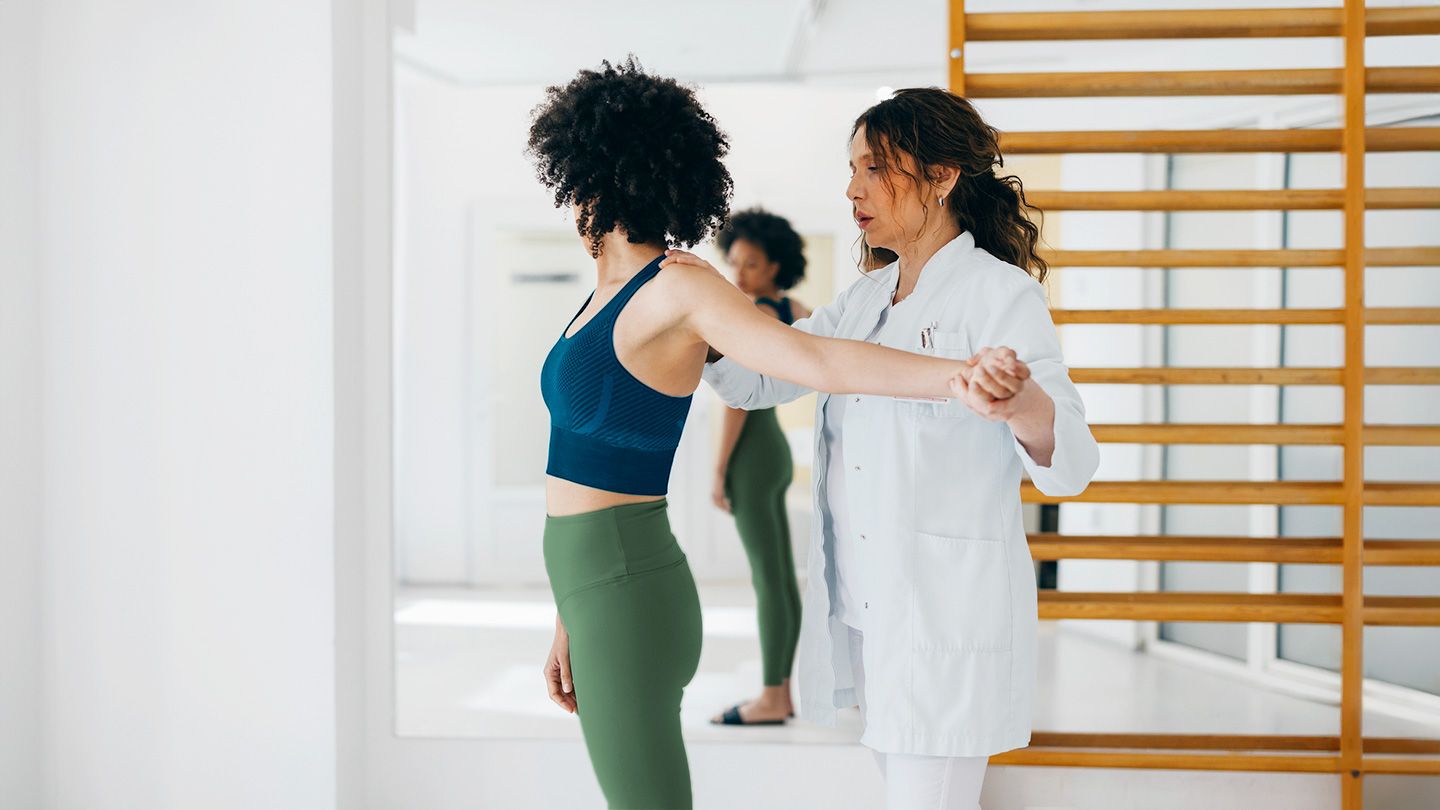If you’ve been diagnosed with breast cancer, or are at high risk for the disease, your doctor may recommend you undergo a mastectomy — the surgical removal of one or both breasts to get rid of cancer. As many as 33 percent of women with either stage 1 or 2 breast cancer undergo a mastectomy, according to the American Cancer Society (ACS),
[1]
while about 65 percent of women with stage 3 breast cancer go through the procedure. After any type of breast cancer surgery, you may experience some side effects, according to the ACS,
[2]
which usually includes some surgical site discomfort and swelling. You may also experience the following complications after a mastectomy, notes the ACS:
- Chest or upper arm numbness
- Limited movement in the arm or shoulder
- Shooting or burning nerve pain in the chest wall, armpit, or arm
- Lymphedema, or swelling of the arm on the side of surgery
What’s more, up to 60 percent of people may experience a decreased range of motion following breast cancer surgery, which could last for years after recovery if not addressed, according to a 2021 study published in The Breast.
[3]
The good news is you may be able to lessen the frequency and intensity of these complications with the help of physical therapy (PT), both before and after your mastectomy. One review published in 2022 suggests that receiving PT before breast cancer treatment may offer self-management support and allow for better understanding of your needs as you begin treatment.
[4]
After surgery, PT may be able to help you recover with fewer complications, according to the Breast study.
“Exercise generally contributes to holistic wellness, and studies also show that exercise improves survival and reduces recurrence of cancer risk,” says Monique Gary, DO, a breast surgical oncologist and the medical director of the Grand View Health Cancer Program in Sellersville, Pennsylvania.
Getting Physical Therapy Before Your Mastectomy
You can meet with a physical therapist before your surgery to help them understand your range of motion, level of strength, and any postural issues, all of which may be affected by your mastectomy, says Christine Hudacek, a physical therapist and certified lymphedema therapist with the outpatient rehabilitation institute at the University of Maryland St. Joseph Medical Center in Towson. This time also gives your therapist the opportunity to take pre-op measurements, so that any lymphedema that may develop after surgery can be spotted, she says.
Physical Benefits
Muscle strength Physical therapy exercises can strengthen weak areas to prepare for faster recovery after surgery, according to Rebecca Viscusi, MD, a breast surgical oncologist in Tucson, Arizona.
In particular, prehabilitation helps increase strength and flexibility in your upper trunk and shoulders, which enhances postsurgical healing, says Nicki Evans, DPT, a physical therapist based in Millville, Delaware. These exercises may include shoulder rolls, arm circles, and stretches — anything that gets your shoulder and chest moving, Dr. Gary says.
Postural awareness Some people who receive anesthesia may experience breathing issues after surgery, according to one 2023 study.
[5]
“Improving posture, and cultivating postural awareness, are essential presurgery benefits, as they enhance muscle efficiency and respiratory function,” Dr. Evans says. One way you can develop postural awareness in your body is by keeping your shoulders back and down, and engaging your core to pull in your abdomen, which supports your back and prevents your hips from tipping forward, according to Stanford University.
[6]
Getting Physical Therapy After Your Mastectomy
While you should make sure to take time to heal after breast cancer surgery, some studies also suggest that physical therapy and general exercise are incredibly important for mastectomy recovery, Gary says. Talk to your doctor before you start exercising to make sure it’s safe to do so. If your doctor says it’s okay, you can start doing light exercise as early as three to seven days after your surgery, per the ACS.
[7]
Physical Benefits
Improved range of motion After a mastectomy, some people may experience tightness under their arms or along their chest wall, Dr. Viscusi says. Some may even experience frozen shoulder — pain and stiffness that may occur in the shoulder after surgery. “PT can help patients regain their full range of motion, and can help lessen some of the tightness, which in turn can help reduce pain.”
Pain control Stretching and strength exercises may reduce pain after breast cancer surgery, according to the study published in The Breast.
[3]
The study found that in the 157 women who participated in physical therapy in the six months following their surgery, about a third reported no pain after one month, and nearly two thirds of participants reported no pain after six months.
Lymphedema prevention and treatment If you had lymph nodes removed during your mastectomy, there’s a chance you may develop lymphedema. Some physical therapists are trained in lymphedema treatment, and can help decrease or prevent swelling, Viscusi says.
Scar management Sometimes, scars can form as a result of mastectomy and cause pain. A review published in 2020 in the Journal of Alternative and Contemporary Medicine suggests that physical therapy in the form of scar massage may be able to help reduce scar pain. The review also found that massage can help decrease the appearance of scarring after mastectomy.
[8]
Respiratory management Early post-operative movement — like taking short walks — coughing to keep your lungs clear, and deep breathing exercises have been found to be helpful in addressing respiratory issues following breast cancer treatment in general, according to a study published in Contemporary Oncology.
[9]
“Emphasizing postural awareness is also crucial, as it contributes to improved respiratory function following mastectomy,” Evans says.
Non-Physical Benefits of Physical Therapy Before and After Mastectomy
The pre– and post–breast cancer surgery benefits of PT aren’t just physical. The 2022 review published in Breast Cancer Research and Treatment suggests that receiving PT before breast cancer treatment may improve not only physical function, but also quality of life,
[10]
while another study published in 2021 found that prehabilitation prior to breast cancer surgery helped to reduce anxiety in participants.
[11]
“Similar to PT prior to surgery, PT can also benefit a patient psychologically after mastectomy by helping them to feel better, stronger, and more in control of their recovery,” Viscusi says.
Education While preparing for surgery, the amount of information thrown at you can feel overwhelming. But speaking with a physical therapist, particularly one who specializes in breast cancer surgery recovery, can offer insights on lymphedema prevention, Evans says. Your physical therapist can also teach you how to do each exercise correctly, and adjust your position as you do them.
After breast cancer surgery, your doctor should provide you with information on what was done during the procedure and what you should expect as you recover. Even so, the time after surgery can feel like a whirlwind, and it can be easy to forget some of your doctor’s instructions. Your physical therapist, who you’re likely to visit a couple times a week post surgery, can answer your questions about your level of movement and any physical limitations that may follow surgery.
Psychological support Working side by side with a physical therapist, someone dedicated to making you stronger and who understands what you’re going through, can be uplifting, both before and after your mastectomy, Hudacek says. During your PT appointment, you’ll also get the opportunity to ask questions, share your concerns, and actively participate in your treatment. “All of which can contribute to a stronger sense of healing and fuller recovery,” she notes.
Moderate exercise in general may also improve your mental health, particularly by reducing anxiety, depression, and stress, according to the American Psychological Association.
[12]
Adaptation assistance Once you get home, you may not be able to do everything you could do prior to surgery. Not only can your physical therapist help you regain your strength, but they can also teach you tips and tricks for daily activities, like showering or cooking, so you can carry out these tasks independently as you heal.
What to Expect From Your Physical Therapy Appointment
During your first visit, your therapist will likely ask a series of questions to gauge your current pain level and mobility, and make a plan for your recovery. If you are seeing your therapist prior to your procedure, your PT will use this time to establish a baseline of activity and range of motion, especially in your arm and shoulder.
Exercises
After a detailed evaluation, your therapist will walk you through a few light stretches and exercises. They should give you specific instructions on how exactly to move and how many repetitions to do.
As you move through these exercises, your therapist will ask about your pain level and adjust your movement as needed. If you feel any sudden, sharp pain, stop the movement and let your therapist know right away.
Exercises to Do at Home
After you’re finished with the session, your physical therapist will give you instructions on exercises you can do at home. Your therapist may also send you home with printed instructions, featuring pictures, for you to reference.
“It is important to talk to your doctor or therapist about which of these are right for you, and when you should start doing them. Also, you should not do any heavy lifting, housework, or driving until your surgeon gives a nod,” Gary adds.
How to Find a Physical Therapist
Any physical therapist can assess your range of motion, strength, balance, and gait following surgery, Hudacek says. A certified lymphedema therapist (CLT) may be able to offer more specialized care post-mastectomy.
“These therapists possess specific knowledge of the rehabilitation protocol, use a more personalized approach, and stay up-to-date on the latest best practice guidelines,” Evans says.
Provider Recommendation As you prepare for your mastectomy, you will probably have a visit or two with your surgeon. During your visit, you can request a few recommendations for a physical therapist who specializes in both pre- and post-mastectomy care. Your doctor’s office can also send a referral to a physical therapy group of your choice, so you can get started as soon as possible.
Personal Referral If you are part of a breast cancer support group of any kind, you can ask around for personal referrals. People may be able to recommend a therapist they have been to, and tell you about their PT experience.
Insurance Provider List Not sure which physical therapists are covered under your insurance? Most insurance companies offer a provider list or search engine on their website so you can find the right therapist for you.





